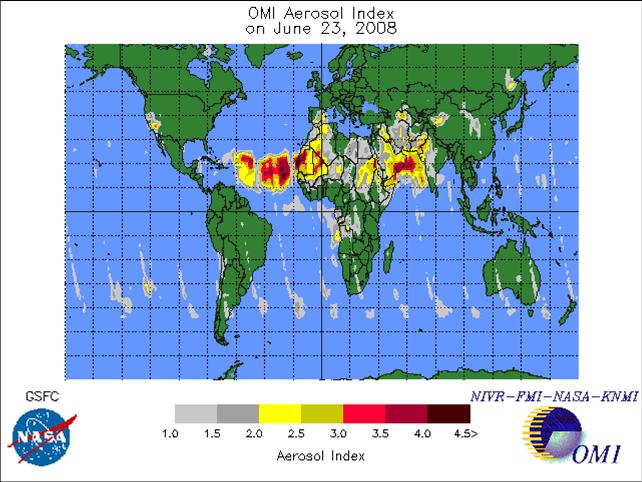
TOMS/OMI Absorbing Aerosol Index
 |
The TOMS / OMI aerosol index is a measure of how much the wavelength dependence of backscattered UV radiation from an atmosphere containing aerosols (Mie scattering, Rayleigh scattering, and absorption) differs from that of a pure molecular atmosphere (pure Rayleigh scattering). Quantitatively, the aerosol index AI is calculated from the ratio of measured to calculated 360 nm TOMS / OMI radiances. Under most conditions, the AI is positive for absorbing aerosols and negative for nonabsorbing aerosols (pure scattering).
|
Dust Aerosols / Recent Result 23 June 2008
|
 |
| Satellite: | Nimbus-7 / Earth Probe / Aura |
| Instrument(s): | TOMS / TOMS / OMI |
| Instrument/algorithm PI: | Jay R. Herman, NASA - University of Maryland P.K. Bhartia - NASA |
| Contact details: | Jay.R.Herman[at]nasa.gov Pawan.K.Bhartia[at]nasa.gov |
| Parameter(s): | Absorbing Aerosol Index |
| Aerosol algorithm: | Ratio of measured to calculated UV radiances |
| Cloud screening: | Not Needed |
| Aerosol model: | None used |
| Retrieval assumptions: | Ground reflectivity has little or no wavelength dependence |
| Retrieval limitations: | only aerosol index, not AOD |
| Spatial, temporal coverage: | 1978 - present / NRT, global |
| Spatial, temporal resolution: | OMI - 13x24 km² / 14-orbits per day / Daily Global Coverage TOMS - 50x50 km2 / 14-orbits per day / Daily Global Coverage |
| Operations status: | OMI is operational |
| Validation status: | While the AI is qualitative, it has been compared to AERONET ground-based measurements to show that the AI tracks the measured optical depth. The AI value is sensitive to the height of the aerosol plume. |
| Quality control: | Quality control depends on the radiometric calibration of the satellite instrument, especially as a function of view angle. In addition, there are wavelength dependent surface effects and lack of sensitivity to aerosols below about 1 km. These effects cause non-aerosol related "noise" to appear in the AI signal. To minimize these effects in AI, an arbitrary cutoff in small values is applied to the AI so that plumes of dust and smoke are easily seen. |
| last algorithm version: | Version 8 |
| last validation: | Summer 2009 |
|
Version explanation
|
Validation summary
|
|
